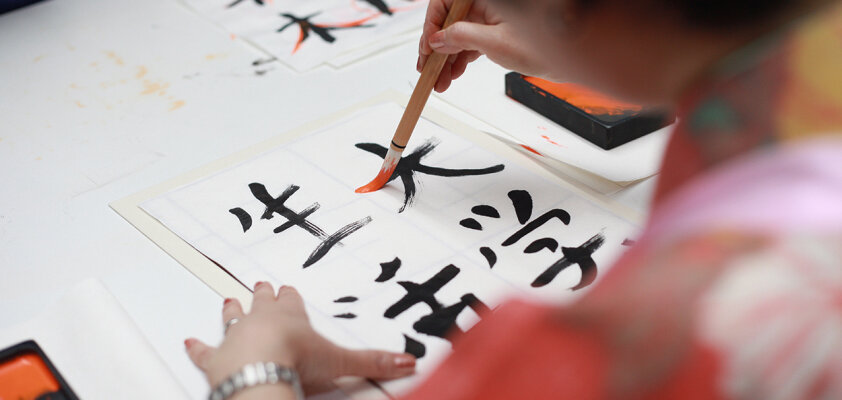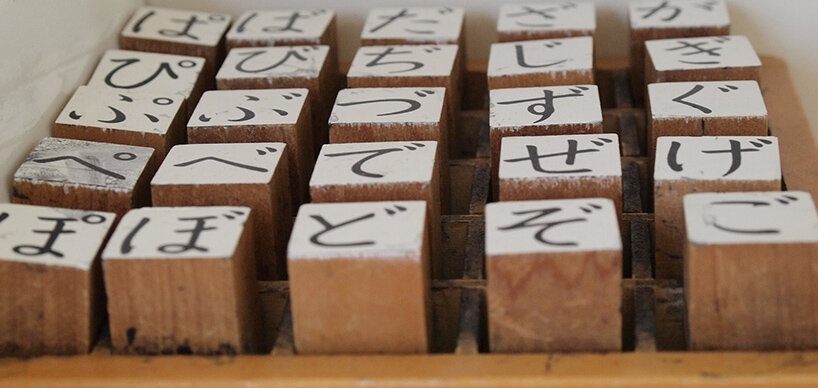Japanese Learning Made Easy

Nihongo o wakarimasu ka? Do you understand Japanese? This question will probably encounter every guest in Japan sooner or later. Because a visit to the Land of the Rising Sun is possible without language skills, learning to speak Japanese is still worthwhile and can be very entertaining.
How do I start learning?
For beginners, the Japanese language may seem like something that can hardly be mastered. Three types of characters, intricate politeness forms, and then there's the pronunciation – how can one learn all of that? Our answer: With patience, joy, and a lot of practice. After all, every new language is an adventure that not only keeps our brain cells active but can also teach us a lot about the culture and peculiarities of a country. Learning Japanese is not easy, but it is very exciting.

This adventure can also begin well in your own city. At your local adult education center (Volkshochschule or VHS), Japanese courses are likely to be offered, introducing the basics of the language to every beginner and preparing advanced learners for their stay in Japan. Usually, learning is done with a book that can be read at home as well. However, the correct pronunciation and writing of words are best practiced in a group.
If you have little time and want to invest less money in learning Japanese, you can also find the right language course or an app for learning Japanese online. Such courses are best suited – especially as a complement to regular classes – for quickly learning the basic characters of the Japanese language, for example:
- Hiragana: The most essential form of script used for "original" Japanese words. In principle, every word can be written with the syllables of Hiragana.
- Katakana: Here, too, are individual syllables, but they are used for loanwords from other languages: doa for "door" (from English "door"), kohii for "coffee," konpyuta for "computer," and many more. Since there is a limited set of Japanese syllables, each word is adapted to the Japanese script. Can you recognize arubaito, tsaitogaisuto, and baumukuhen?
- Kanji: These are originally Chinese characters, but in Japanese, they often have a different pronunciation compared to Chinese. However, the meaning remains the same, giving Chinese speakers a significant advantage in learning. In this case, one Kanji represents a whole word or a part of a word.
-
Romaji: Japanese words written in Latin script are called Romaji. This allows beginners to directly learn pronunciation and meaning while still learning Japanese characters.
For Hiragana and Katakana, one week each is sufficient to learn how to read and write them – regular practice afterwards is a must. Learning Kanji takes considerably longer. To be able to freely read a Japanese newspaper, one should learn at least 500. In total, there are tens of thousands of such characters – and probably no one in Japan knows them all. Just over 2000 are used in common language and taught in schools. To quickly master Kanji, there are many sophisticated techniques, and as learning aids, they are often provided with Hiragana in many texts – for example, in manga – to depict how they are pronounced.
As a practice option on the go and for listening to pronunciation, an online course is suitable. Because it holds true: the more regularly one trains in a foreign language, the faster one reaches the goal. Learning Japanese can also be done on the side. It's even better with a tandem partner, whom you can also find online – this way, you can exchange language skills.
How to prove your Japanese skills from the language course for studies, work, and emigration? While Western languages follow the European Reference Framework with levels like A1, A2, etc., the division in Japanese is a bit different. The levels range from N5 to N1 – the smaller the number, the higher the proficiency level. N5 can be achieved with about a year of language courses, N1 is almost native speaker level and takes, if you stay consistent, about five years – depending on prior knowledge. These levels are part of the JLPT, the "Japanese-Language Proficiency Test."
Speaking among Japanese
If you want a vacation of a special kind, you can also enroll in a language school abroad. After all, a language is best learned where it is spoken in everyday life. Japanese courses directly on-site have the advantage that you can clarify all questions with native Japanese speakers and actively apply every learned word and lesson: theoretically, anyone can learn to introduce themselves, order in a restaurant, and ask for directions – but what if you actually find yourself in that situation?

Japanese grammar and sentence structure are relatively easy to learn. Those who master the basics will quickly be able to form simple sentences. It is important to know the right vocabulary for this: without it, communication will be challenging. Therefore, it is recommended to quickly acquire a broad vocabulary.
This is particularly valuable because English doesn't get you very far in Japan. In a large city like Tokyo, tourists may find many signs in a readable script next to the Kanji. However, if you ever get lost and want to ask a local for directions, you may often receive a puzzled smile, even in the metropolis – because even if the local can speak English, they may hesitate to use it. In this society, it is "embarrassing" not to know something precisely – it's all or nothing. Therefore, it is even more important to unpack your imperfect Japanese skills and make communication easier for your conversation partner. They will be grateful to you.
Word for word: Crash course Japanese
To help you navigate your trip to Japan successfully, we have gathered here the essential words in Japanese that beginners should know. When written in Romaji, "ou" represents a long "o".
- Good morning: Ohayou gozaimasu
- Good day: Konnichi wa – this is quite formal and is used rather infrequently. When you want to personally greet someone, it's better to call them by their name: Ah, [Name]-san!
- Good evening: Konban wa
- How are you?: O-genki desu ka? – Unlike in our culture, this is asked only to people you haven't seen in a while. The response "I'm fine" is: Genki desu
- Excuse me: Sumimasen – this is most commonly used when you want to get someone's attention. For a sincere apology, such as when you accidentally bump into someone, use Gomen nasai
- Thank you: Arigatou – adding gozaimasu makes the statement even more polite. The most polite form is: Doumo arigatou gozaimasu
- Please: When placing an order, add o kudasai or the slightly more polite onegaishimasu at the end: Ramen o kudasai – Ramen, please! When giving something to someone, say douzo
- Yes / No: Hai / Iie
- My name is…: Namae wa [Name] or [Name] desu. Even though watashi wa means "I," it is usually omitted here since the person you're talking to already knows who you are. Note: When addressing others, add -san to their name, but refrain from doing so for yourself! If you want to ask someone's name, simply say: O-namae wa?
- Where is …? … wa doko desu ka? Eki – Station, toire – Toilet, otera – Temple …
- I don't understand: Wakarimasen – "I don't understand Japanese" is: Nihongo o wakarimasen. "Do you understand English?" on the other hand is: Eigo wakarimasu ka?
- Goodbye! An informal goodbye is Dewa mata or Mata ne – "See you soon"! If you want to say goodbye in a store, a simple Arigatou gozaimashita (the past tense of the gratitude expression) is sufficient. It's advisable not to use the famous Sayounara, as it roughly translates to "Farewell!"
You may have already noticed one thing about these expressions: a difference from other languages is that, like in Japanese culture, a lot of emphasis is placed on politeness. While in our culture, we have formal and informal forms of address, even Japanese native speakers find it challenging not to make a misstep. You can read more about this in our article "Japanese Addressing Etiquette".
Japanese vocabulary can also be fun
If you've ever watched Japanese movies or anime in their original language or heard native Japanese speakers, you know that this language can be not only strict and complex but also very amusing and expressive. We've compiled a list of amusing or simply positive expressions that can sweeten the process of learning Japanese:
- Sugoi: Wow, impressive!
- Kawaii: Cute!
- Iine! That's good!
- Tanoshii: It's fun. To wish someone a lot of fun, you say Tanoshite kudasai – literally "Please have fun!"
- Moshi moshi: Hello? (on the phone)
- Tokidoki: Sometimes – not to be confused with doki doki, the sound of a beating heart
- Yoisho! Often sounds like "yosh" and is meant as a encouraging sound – for oneself before a challenge or for others
- Irasshaimase! Every visitor in a Japanese store is greeted with a loud and sharp "Welcome"
- So so so! Yes, that's right (affirmative) – the more often it's repeated, the more affirmative it is. When pronounced with a questioning tone, it can be translated as "really?"
- Eeee? Expresses surprise – the longer and higher, the more surprised.
Anywhere in the world, knowing the language of a country helps you get by – and in Japan, every word you understand and can say yourself is valuable. Conversely, a course in a foreign language can feel like a visit to Japanese culture with all its diversity, openness, and a touch of eccentricity. Words for concepts or natural phenomena for which we have no term, onomatopoeias, and wordplay make this language unique and learning a true experience. Many such expressions can also be discovered on our pages. Ganbatte – good luck!











-from-the-yakiyaki-grill-pan.jpg)




